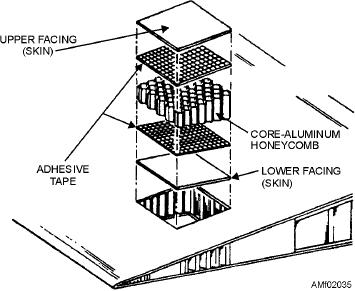
GRAPHITE.--Carbon graphite fibers were first
developed by Thomas Edison while experimenting
with the incandescent light bulb. It is made from
synthetic material and carbonized in an inert
environment at temperatures around 3000F. Carbon
fibers are readily woven into various patterns. They are
used to manufacture complex contoured parts. The
majority of advanced composite parts on naval aircraft
are made of carbon fibers.
KEVLAR.--DuPont's Aramid Kevlar material
is a synthetic polymer. Although these fibers may be
readily woven into fabrics, they have poor compression
properties that limit their use to internal ducts,
nonstructural access covers, fairings, and lightly loaded
helicopter skins.
BORON.--Boron fibers are made by chemical
vapor deposition (deposits) of boron onto a tungsten
wire 0.0005" in diameter. Boron fibers have a high
Figure 2-35.--Sandwich construction.
bending stiffness, and cannot be easily woven into cloth
or used for complex contoured parts.
alloy core, sandwiched between aluminum alloy sheets,
Construction
called "facings." The facings are bonded to the
lightweight aluminum core with a suitable adhesive so
Laminate construction consists of skin and
as to develop a strength far greater than that of the
substructures that are manufactured by laminating plies
components themselves when used alone.
of preimpregnated material (prepreg). Sandwich
construction parts used on naval aircraft can be divided
Another type of structural sandwich construction
into two broad classes: (1) radomes and (2) structural.
consists of a low-density balsa wood core combined
with high-strength aluminum alloy facings bonded to
LAMINATE CONSTRUCTION.--Prepreg is
each side of the core. The grain in the balsa core runs
the basic building block of advanced composites. It
perpendicular to the aluminum alloy facings, and the
consists of fibers preimpregnated with partially cured
core and aluminum facings are firmly bonded together
matrix material. These plies of prepreg are cut to the
under controlled temperatures and pressures.
proper size and shape and stacked in specific fiber
orientation. This stack up is then fully cured using heat
The facings in this type of construction carry the
and pressure. Excess resin bled during the cure bonds
major bending loads, and the cores serve to support the
the plies together to form a solid laminate.
facings and carry the shear loads. The outstanding
characteristics of sandwich construction are strength,
SANDWICH CONSTRUCTION.--The first
rigidity, lightness, and surface smoothness.
class, radomes, is a reinforced plastic sandwich
construction designed primarily to permit accurate and
Q2-42.
What type of plastic will soften when heated
dependable functioning of the radar equipment.
and harden when cooled?
The second class, referred to as structural
Q2-43.
What type of plastic will harden when it is
sandwich, normally has either metal or reinforced
heated?
plastic facings on cores of aluminum or balsa wood.
Q2-44.
Plastic sheets should be stored in a bin and
This material is found in a variety of places, such as
must be tilted at least how many degrees from
wing surfaces, decks, bulkheads, stabilizer surfaces,
vertical?
ailerons, trim tabs, access doors, and bomb bay doors.
Q2-45.
What are the three types of advanced com-
Figure 2-35 shows one type of sandwich
posites used on naval aircraft?
construction that uses a honeycomb-like aluminum
2-43

